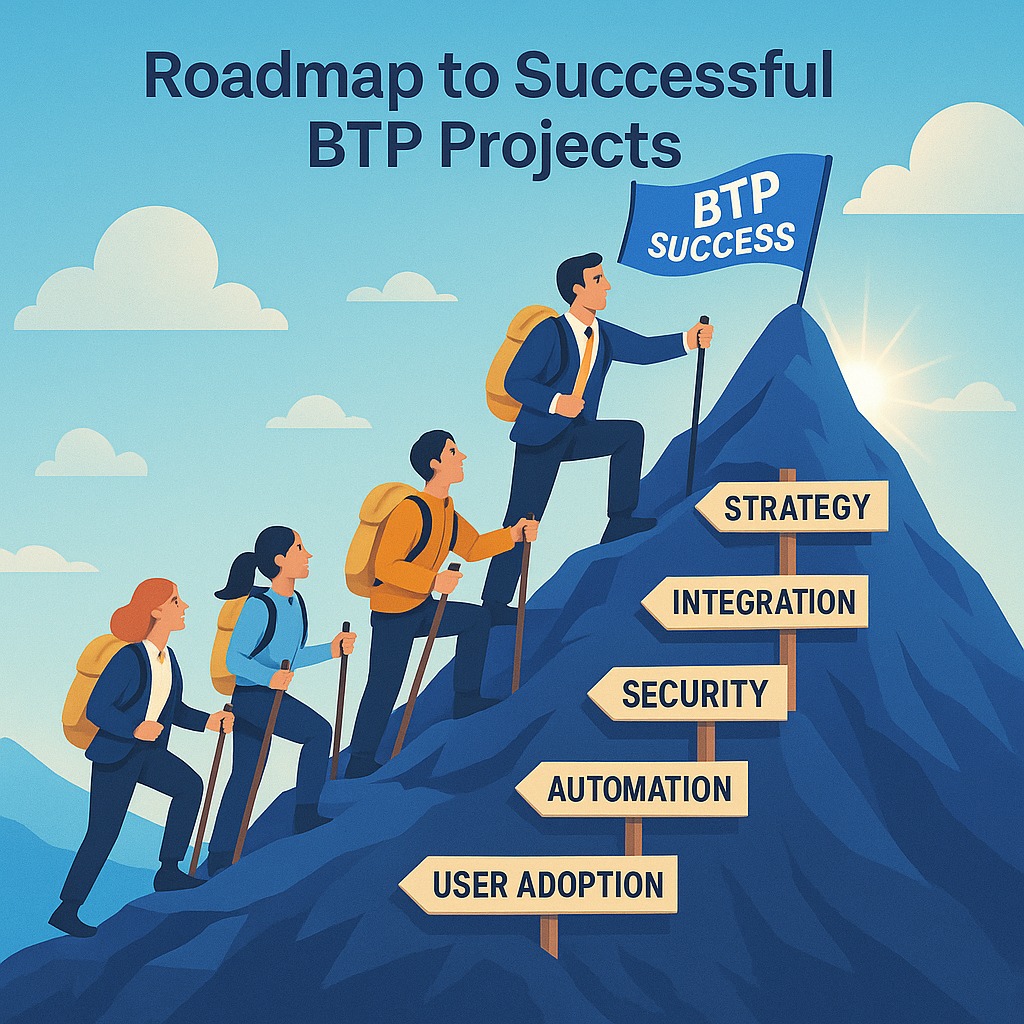A structured methodology is key to the success of any SAP Business Technology Platform (BTP) project. This comprehensive approach ensures that every phase is well-planned and executed, reducing risks and maximizing business value. The following outlines a detailed, step-by-step process that covers all critical stages, from initial discovery to continuous improvement in the run phase.

Discovery Phase
The project begins with the discovery phase, which is focused on understanding project requirements and defining clear objectives. During this phase, stakeholders gather detailed requirements, review business processes, and analyze current systems. The main goal is to identify the problem that the new solution will address and determine the expected value to the business. At this stage, it is also essential to review the landscape to decide which SAP systems and solutions will be utilized and to outline the potential integration points.
Sample Deliverables/Outcomes:
- Project Charter
- Vision and Scope Document
- Business Process Maps
- Fit-gap documents
Design Phase
Once the requirements have been defined, the design phase comes into play. This phase involves creating a blueprint for the solution, including architecture design, user experience (UX), data flows, and security considerations. A clear design document is developed to guide the build process. Emphasis is placed on designing a solution that supports a clean approach, where custom extensions are built on BTP without altering the standard SAP system. Prototyping and iterative reviews with stakeholders ensure that the design aligns with both technical and business needs.
Sample Deliverables/Outcomes:
- Solution Architecture
- Functional and Technical Specifications
- Product Backlog
- UX/UI Design Prototypes and Wireframes
- Data Flow Diagrams
- Integration Design Specifications
- Security and Compliance Requirements
Build Phase
In the build phase, the actual development of the solution takes place. This phase includes coding, configuration, unit testing, test scripts and the development of custom applications or extensions using BTP tools. It also involves setting up necessary integrations with existing SAP systems or third-party applications. Rigorous development practices are followed to ensure quality and maintainability.
Sample Deliverables/Outcomes:
- Developed Code and Configurations
- Custom Applications binaries (e.g., CAP or RAP-based extensions)
- API Endpoints and documentation
- Unit Test Reports
- Test automation scripts
- Peer reviews and code quality assessments
Integration Testing
After the build phase, integration testing is conducted to verify that all components of the solution and all the other systems that it touches work together seamlessly. This phase focuses on testing the data flows, APIs, and integrations. The testing ensures that the new solution integrates and fits well within the end-to-end business processes, and any issues related to connectivity or data exchange are identified and resolved before moving forward.
Sample Deliverables/Outcomes:
- Integration Test Plans and Cases
- Test Data
- Defect Logs and Resolution Reports
- Performance and security test assessment and issue resolution reports
Acceptance Testing
Once integration testing is complete, the solution undergoes acceptance testing. This phase involves end users and business stakeholders who validate that the solution meets all defined requirements. User acceptance testing (UAT) focuses on functionality, usability, and performance, ensuring that the solution performs as expected from a production or enterprise grade solution. Feedback from this phase is used to make necessary adjustments before starting the prep for go-live.
Sample Deliverables/Outcomes:
- User Acceptance Test (UAT) Plans and Cases
- UAT Sign-off
- Feedback and Issue Tracking Reports
- Final Change Request Documentation
Data Migration
For projects involving legacy systems, data migration is a critical phase. Data migration involves transferring historical data from old systems to the new SAP environment. This process requires careful planning, data mapping, and validation to ensure that all necessary information is accurately transferred and that data integrity is maintained throughout the process.
Sample Deliverables/Outcomes:
- Data Migration Strategy and Plan
- Data Mapping and Transformation Documents
- Test Migration Results and Validation Reports
- Final Migration Execution Report
Cutover and Go-Live
The cutover phase marks the transition from the old system to the new solution. This phase requires detailed planning and coordination to minimize business disruption. Activities during cutover include final data migration, system configuration changes, and end-user training. Once the new solution is live, it is essential to monitor the system closely and provide support as users begin to adopt the new processes.
Sample Deliverables/Outcomes:
- Cutover Plan and Schedule
- Go-Live Readiness Checklist
- End-User Training Documentation, Videos, etc.
- Deployment and Rollout Plan
Hypercare Phase
Immediately following go-live, the hypercare phase is critical for stabilizing the solution. During this period, the project team provides intense support to quickly resolve any issues that arise. Hypercare ensures that any operational glitches are addressed promptly, and users receive the assistance needed to transition smoothly to the new system.
Run Phase and Continuous Improvement
The final phase is the run phase, where the solution becomes part of the regular operations. Continuous monitoring, performance optimization, and regular updates are integral to this stage. Feedback is collected to identify areas for further improvement, and the solution is iteratively enhanced over time. This phase represents an ongoing commitment to ensuring that the solution remains effective and aligned with evolving business needs.
Sample Deliverables/Outcomes:
- Operational Monitoring and Performance Dashboards
- Regular Update and Enhancement Roadmaps
- Periodic Review and Audit Reports
- Continuous Improvement Action Plans
The methodology outlined here serves as a strong foundation for any organization considering the adoption of SAP BTP. It emphasizes the importance of planning, rigorous testing, and continuous improvement. With each phase carefully executed, professional services organizations can deliver solutions that not only meet current business needs but are also prepared for future growth and innovation.
